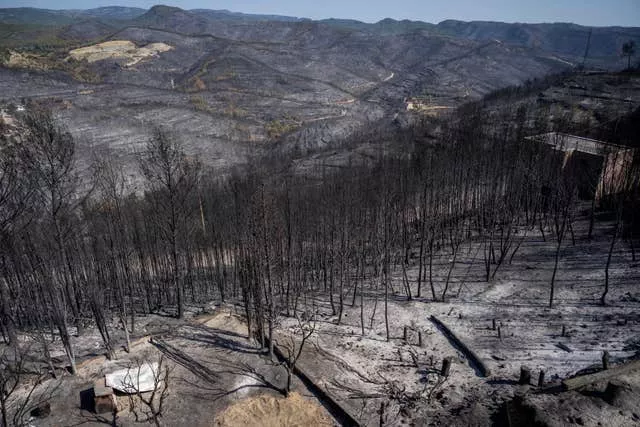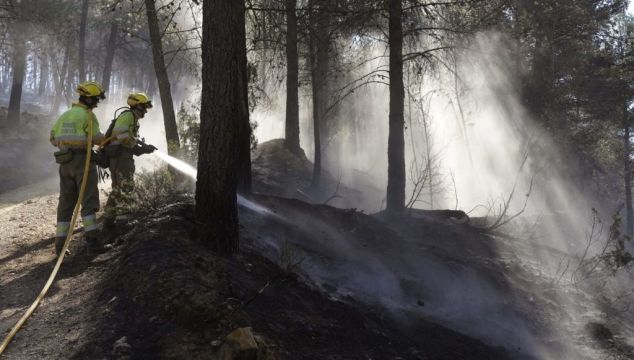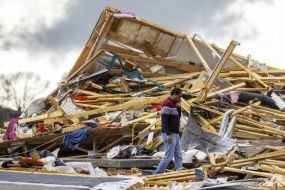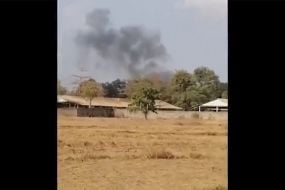Surveying the hills covered with near bone-dry pines stretching to the Pyrenees in the distance, Asier Larranaga has reason to be on guard.
This part of north-east Spain is, like large swaths of the Mediterranean country, braced for wildfires due to the lethal combination of a prolonged drought, record-high temperatures and increasingly dense woods unable to adapt to a fast-changing climate.
Mr Larranaga is one of the top fire analysts for the firefighters of Catalonia charged with safeguarding the region’s homes and landscapes. While grateful that some desperately needed rain has finally fallen in recent weeks, he is ready for the worst – unless July and August buck Spain’s historic trend of being the hottest and driest months of the year.
“If we have a normal summer… and conditions of low humidity combined with high temperatures, then we will see fires that quickly expand beyond our extinction capacity,” he warned.
“For areas where it has not rained in May and this month, we could see these types of fires as early as next week.”
Spain suffered the biggest losses from wildfires of any European Union country last year amid a record-hot 2022. Four people, including one firefighter, died in blazes that consumed 306,000 hectares.
With Spain sweltering under a record-hot spring, it is again leading the continent in 2023 with 66,000 hectares turned to ash.

Now firefighters like Mr Larranaga across Spain are preparing for a potential scorcher of a summer.
The fires coincide with Catalonia and a large part of Spain’s south bearing the brunt of a drought that started last year and has only recently been somewhat alleviated by rain. The central reservoirs for Catalonia, which provide water for some six million people including Barcelona, are still only at 29% of capacity and water restrictions remain in place.
Climate change is playing a direct role in propagating these fires, experts agree. The increasing temperatures have made the plants that are used to more mild weather vulnerable to both plagues and fire.
Spain, like the rest of the Mediterranean, is forecast to heat up faster than the global average. Spain saw fires that showed the virulence of a summer outbreak break out as early as March. Northern Europe is also battling blazes spurred by drought.
Mr Larranaga, 52, is a member of Catalonia’s Graf – its elite wildfire fighting unit. Catalan firefighters are currently helping in Canada as part of a Spanish contingent sent to combat the massive fires that have sent smoke over the United States and as far as Europe.
He was speaking in the rural town of Solsona, two hours north of Barcelona, where he oversaw a training session by the local fire brigade.

Practice included simulating a last-resort protection manoeuvre used in cases when firefighters are trapped by the flames. They clear an area of vegetation and take refuge in their truck, which is equipped with sprinklers. The firefighters said they hope it is a manoeuvre they will never have to use.
The Solsones county, home to Solsona and its 9,000 residents, does not normally have large fires thanks to storms generated by the Pyrenees. But the downside is that its forests build up vegetation, or “fuel” for potential fires, that become vulnerable to a lightning strike, a spark from farm machinery, or arson.
In 1998, a fire consumed 27,000 hectares in the country. Now Mr Larranaga is concerned that the landscape is primed to ignite again.
“The fires in these conditions can be very intense like the enormous ones we are seeing in Canada,” he said.
He added that his worst-case scenario is “a situation where you have people, in a panic, trying to flee, who put themselves in danger because the access roads cross wooded areas”, stirring up memories of a tragedy in neighbouring Portugal when more than 60 people perished in a fire disaster in 2017.
Catalonia’s firefighters were tested last year by fires that erupted just when the official fire season started in mid-July.

That close call, fire chief David Borrell said, motivated their decision to increase the fire campaign to four months from three and start it a month earlier. That means more manpower and more aircraft for a longer period of time.
Mr Borrell said this new generation of more powerful fires has led to two changes in how they are fought. First, it is no longer possible to just “attack” a fire, firefighters have to wait for it, and, if need be, sacrifice unfavourable terrain – whether due to its position related to the wind, access or vegetation – if it means keeping the firefighters from wearing themselves out or even risking their lives.
“The second change is how to deal with simultaneous fires without getting overwhelmed,” Mr Borrell said at the Catalan firefighters’ hi-tech headquarters near Barcelona.
“If you go all out against a fire, then you won’t be able to handle a second one, and with a third fire you collapse. So to avoid that, we consider everything in one process. That is a potent strategy change we began last year. And for me it is a game changer.”
The challenge, however, is still daunting with summer now here.
In addition to turning the terrain into a tinderbox, drought is complicating the firefighters’ ability to work: some of Catalonia’s reservoirs have been ruled unusable for water-dumping aircraft due to their lack of their low levels of water.
“If we hadn’t had the rain we saw in May, we would now already be in a campaign of large fires,” Jordi Pages, a wildfire expert for the Pau Costa Foundation fire awareness organisation.
“But we still had a spring with below average rainfall, so we can expect an intense summer.”







